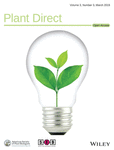Faculty and Students Unlock Clues to “Wood Wide Web”
Rockers don’t wait to make a mark. Working side-by-side with supportive faculty, they produce important and lasting intellectual contributions right away. And they’re recognized for it.
Eric Yi ’16 and Samantha Statter ’16 joined professors Eric Kramer and Donald McClelland, and Joseph Carlson of the Joint Genome Institute, as co-authors of an academic research paper that provides new insights into one of the big mysteries in forest ecology.
Forest trees are often connected by their roots to a vast underground network of fungal filaments, sometimes called the “Wood Wide Web.” The trees pass sugar to their fungal partners, and in return the fungi provide crucial nutrients extracted from soil. The web also acts as a communal sugar bank. Sugar deposited into the web by one tree can end up in neighboring trees 10 meters away.
The big mystery is how trees manage this interaction. If a root tip encounters a fungal filament, how does it know if this particular fungus is friend or foe? Should the tree hand over some sugar, or should it make antifungal defensive compounds? It’s a decision that could mean life or death.
The Simon’s Rock researchers didn’t initially realize their project would be important for plant-fungi interactions. Students Eric and Samantha were busy compiling information on plant genomes, and the rest of the team were using that information to study how large gene families change in size among different plant species. Eventually, they noticed that several gene families were especially large in plants that can exchange material with the Wood Wide Web. The gene families that stood out mostly encode chemical receptors: proteins similar in function to human taste and odor receptors but evolved to detect different chemical compounds. The genomes of plants that can talk to the Wood Wide Web encode for hundreds of extra receptors. The researchers hypothesize that effective communication with the Wood Wide Web may involve a cross-talk using dozens or even hundreds of different chemical signals.
The findings are published in the paper “Flowering plant immune repertoires expand under mycorrhizal symbiosis” in the journal Plant Direct.
The research was published in the March 2019 issue of Plant Direct.
